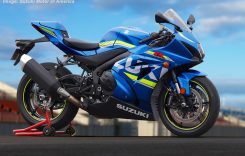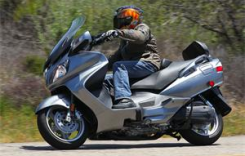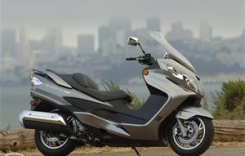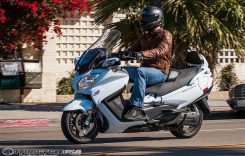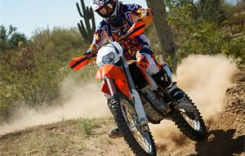One of the recent trends in motorcycling is the development of ergonomically-forgiving sportbikes. Perhaps this is a consequence of the even more prominent motorcycling trend, evident for decades now, of the steady advance of the average rider age. And not all those Boomers and 40/50-somethings are buying cruisers, a lot of them are hardcore sportbike riders, who still want performance, but without the track-biased riding position. At least, those were the dots I connected during Suzuki’s press presentation describing the demographic target of its new 2016 model GSX-1000/F models.

Personally, my 38-year-old mind doesn’t need any convincing, as the merits of these models appeal to common sense. While the race-inspired Supersport and Superbike platforms are thrilling, without question, they are almost comically over-performing for real-world conditions. Would I like 180 horsepower? Sure. Would I be happier with a mere 140 hp but be able to enjoy that performance without my wrists, legs and back crying out in agony after a handful of miles? Yes, that sounds better. Some young, limber folks are scoffing at such fogey-ish thinking. To which I say, with all sincerity, enjoy your youthful vigor and happily burn the performance candle at both ends with the myriad of track-inspired offerings available (of which you can read in MotoUSA’s 2015 Superbike Shootouts). But I’m confident some other readers are more in accord with my reasoning, and for whom these GSX-S designs are tailor made.
The formula for bikes like the GSX-S1000 models follow a familiar pattern. Borrow an existing sportbike engine (in this case the 2005 version of the GSX-R1000), tune it for a more street-friendly powerband, and then mate it to a sporty chassis with the key alteration being a more upright, standard riding position and relaxed ergonomics. And, since no one is tracking laptimes with a stopwatch or giving you messages on a pitboard during your typical weekend playride, all the cutting-edge electronics and top-shelf, competition-grade braking and suspension components aren’t a necessity. This approach has often produced “naked” versions of a marque’s literbike platform, including designs like the Yamaha FZ1, Honda CBR1000R and Kawasaki Z1000. Kawasaki took things in a more traditional sportbike direction with its fully-fared Ninja 1000 – a versatile, street-friendly offering that serves multiple roles, not the least of which is being one of MotoUSA’s favorite sport-touring mounts. Suzuki’s 2016 GSX-S1000 and GSX-S1000F are most analogous to the Z1000 and Ninja 1000. And while Suzuki might be late to the party, I’m glad they finally made it, because these GSX-S1000 models do impress.
GSX-S1000

Our first ride experience aboard both the GSX-S1000 models took place in Monterey, California, riding north into the mountainous roads that wind their way from Santa Cruz to San Francisco. The morning stretch was aboard the naked GSX-S1000. And while some readers might find the Suzuki’s lines uninspired, I personally favor them over some of its more aggressively styled competitors. (Suzuki had a Yoshimura-prepped GSX-S1000 model along for the ride too, which looked particularly fetching.) I also found the build quality for the new GSX-S exceeded expectation for bikes with a relatively low MSRP ($9999 – $10,999). In this regard, the new models are the exact opposite of the old GSX1250FA, which seemed like an overpriced, flimsy, parts-bins special by comparison. Instead these new bikes remind me of the latest generation V-Strom designs, from the controls down to the instrument console and its informative and easy-to-read LCD panel.
Tossing a leg over the bike, its 31.9-inch seat height allowed an easy flat-footed reach to the ground for my 32-inch inseam. Part of this is due to the seat shape, which, like most designs nowadays, tapers inward at the tank. The bike feels slender behind the controls, without being cramped, and I immediately liked the placement of its wide aluminum handlebar – a Renthal Fatbar design.
One nifty feature on the GSX-S1000 is its Easy Start ignition, which fires up the bike with a single dab of the starter button (riders also don’t need to pull in the clutch, provided bike is in Neutral). Sure, holding your thumb down for an extra second for the engine to kick over on a regular bike isn’t exactly a hardship, but it’s a convenient gadget on the GSX-S. Of course, it’s what happens after the bike fires up that really matters.
The GSX-S1000 sources a version of the K5 GSX-R1000 Inline Four. The 999cc displacement and 73.4mm bore and 59mm stroke are unchanged, but engineers tuned the S model engine for street performance. New pistons, cam profiles and revised valve timing (those valves being made of steel instead of the R’s titanium) are the most notable revisions, with the GSX-S sacrificing top-end horsepower for improved bottom- and mid-range torque. The S models claim 145 peak horsepower and 78 lb-ft torque, but Suzuki notes that the S churns out more torque down low than its R sibling, which only nets its performance advantage at the upper end of the powerband. By comparison, the GSX-R1000 claims 185 peak horsepower at 11,500 rpm, which is, coincidentally, the where the S models redline.
In practical use, the engine is tuned quite well for the street. The S is content to zoom along in its responsive bottom end, with things getting more interesting in the meaty mid-range. Fueling is immediate, bordering on abrupt in the transition from fully closed throttle to open, but that’s picking nits. Roll on the gas and there is more than ample power for spirited street riding, and once the GSX-S gets spinning up into its top-end things get really interesting! It’s a proper sportbike and only the most hardhearted performance junkies will regard the Suzuki as a neutered GSX-R. This contrasts one of its main rivals, the CBR1000R, which does feel de-tuned and polite when compared to its literbike kin.

I was also impressed with the bike’s sound. The GSX-S had me grinning as I opened up the throttle on the freeway on-ramp with its terrific sounding intake howl and an exhaust note that really does surprise for a stock unit.
Engine performance is exhilarating yet easily managed, which is a tricky balance. There’s no fancy fly-by-wire stuff, and no Suzuki D-Mode with variable engine maps, which I can’t say that I missed all that much. The GSX-S does, however, employ a traction control system. A toggle switch on the right switchgear let riders select between four options, with three different intervention settings (1,2,3) as well as the ability to disable TC. For most of the day I kept the TC setting on 1, which allows some wheelspin and minimal intervention. I didn’t feel any noticeable intervention until switching to higher settings, and only when initiating exaggerated throttle inputs. I found the system effective without being intrusive.
The GSX-S’s six-speed transmission is a no frills unit. True, there’s no slipper clutch or quickshifter, but I didn’t regret their absence. Shifting is snick, snick, snick easy. No bobbles or misses. No abrupt clutch engagement. No complaints.
When it comes to handling, the GSX-S lives up to its sporty pretensions. It sources a twin-spar aluminum frame – which is actually lighter than the R model – and shares the GSX-R swingarm. It’s not as sharp or aggressive as a track-oriented bike, but the S is quick-turning and responsive to inputs. On a particularly tight one-lane road, a car surprised me on a blind corner by crowding into my lane. Mid-corner I was able to pick up and dart out of the way with minimal drama. It’s quick on-its-toes without feeling twitchy or flighty, another tricky balance.
KYB provides the suspension units, with a 43mm inverted fork and single rear shock, and they held up well for a high-speed pace. Our ride took an unplanned detour due to construction, and the impromptu route, which careened through the Redwoods north of Santa Cruz, saw variable road conditions that included several bumpy sections. The GSX-S’s taut suspension, which performed so well on the smooth high-speed surfaces, felt harsh on the less pristine sections. That said, I can’t gripe too much, because I didn’t fuss with the clickers and, thankfully, the units offer a wide range of adjustability – the fork adjustable for preload, compression and rebound, and the shock for preload and rebound.
GSX-S1000F

After lunch at Alice’s Restaurant (a highly recommended stop for riders on Skyline Boulevard), the remainder of the day would be aboard the GSX-S1000F. It’s not an oversimplification to say the F is the same bike with a fairing (I guess that’s what the F is for…). The extra bodywork adds 13 pounds to the naked bike’s 459-pound claimed curb weight. To compensate for this weight change and the fairing’s aerodynamic effect, the front fork utilizes slightly higher oil capacity. Other than that, the bikes are identical.
Surprisingly, my initial handling impression on the F was that it’s smoother and more settled. I’d credit this mostly to the immaculate road surfacing of Highway 84, an epic stretch of road which cuts through La Honda on its way down to the Pacific Coast Highway. Scything through long sweeping the corners, the GSX-S1000F excels. But even factoring in the flawless road conditions, I’d still rate the F’s front end a hair more composed than the naked bike. I suppose the biggest contributing factor here is the steadying aerodynamics of the fairing and windscreen.
Another oddity that I noted aboard the F was that its front brakes didn’t feel as potent. In fact, the first time I hammered them approaching a corner I had “yikes!” moment because they didn’t bite the same as my morning ride and I had to squeeze harder. I didn’t have any notable complaints about the morning S1000’s braking prowess, so I reckon this incident on the F is more likely an anomaly to my individual bike (perhaps the pads hadn’t “bedded in”). Still, Suzuki claims these monobloc Brembo calipers are the same as those used on the 2014 GSX-R models, which I find surprising in hindsight. I’d rate the overall braking performance effective, but not top-shelf. The ABS, which comes standard on F model and as a $500 option on the naked version, does its thing without being distracting.
The GSX-S1000F doesn’t have saddlebag mounts as an option (unlike the R1200RS we recently tested, or its most logical head-to-head matchup, the Ninja 1000), which is a pity, because it would make a fine sport-touring platform. This is a segment last represented in the Suzuki lineup by the aforementioned GSX1250FA. It’s been several years since I’ve ridden the 1250, but based off my hazy memories this new 1000F delivers a far sportier suspension and handling.

Comfort may not be ideal, compared to purpose-built tourers, with the seat being the biggest problem area. Having said that, the upright, slightly sporty riding position is amenable to long-distance rides and far superior to typical sportbike ergos. The F’s fairing does its job well, despite a fairly slender profile and the non-adjustable screen directs a steady airflow. It’s definitely not the full-touring screen, but I didn’t have any complaints with wind buffeting. Of course, I didn’t trek more than 100 miles aboard the F model to really test its sport-touring credentials, but I’m eager to do so in the future and expect it would hold up quite well.
Suzuki GSX-S1000 Highs & Lows
Highs
- Sporty performance with touring-like ergos
- Engine sound impressive for stock exhaust
- Competitive pricing makes for great value
Lows
- No optional saddlebag mounts for F model
- Slight abruptness from closed throttle
- Arrives two years too late for some sport-touring riders
Evaluating these GSX-S models, I think the most enticing aspect might be pricing. The F model, in particular, strikes a bargain at $10,999, undercutting its direct rival, the Ninja 1000 ABS, by a full grand. It’s clear that Suzuki is aggressively pricing these to capture that target demographic mentioned before. Unfortunately, these bikes would have had a much greater impact on the American market had they arrived a couple years sooner, but the GSX-S1000 models are here now and the price is right. They present a fantastic option for consumers craving sporting performance in a street-friendly platform. Stay tuned for comparison reviews in forthcoming weeks.
2016 Suzuki GSX-S1000/F Specifications:
Engine: 999cc, liquid-cooled Inline Four
Bore x Stroke: 73.4 x 59.0mm (2.9 in x 2.3 in)
Compression Ratio: 12.2:1
Transmission: Six-gear with wet multi-plate clutch
Final drive: Chain
Fueling: EFI with SDTV with 44mm Mikuni throttle bodies
Exhaust: Stainless steel 4-2-1
Fuel Capacity: 4.5 gallon
Frame: Twin-spar aluminum
Front Suspension: 43mm inverted KYB fork with 4.7 inches travel; adjustable for preload, compression and rebound damping
Rear Suspension: Single KYB shock with 5.1 inches of travel, adjustable for preload and rebound
Front brakes: 310 mm floating dual discs, with four 32mm piston-equipped Brembo monobloc calipers
Rear brake: 220mm single disc, with single-piston Nissin brake caliper
Front/Rear Tires: Dunlop D214F 120/70ZR17 M/C; 190/50ZR17M/C
Rake/Trail: 25°/3.9 inch
Wheelbase: 57.5 inch
Seat Height: 31.9 inch
Curb weight: 459 pounds (F model 462 pounds)
MSRP: GSX-S1000 $9999, GSX-S1000 ABS $10,499, GSX-S1000F $10,999
- Comfort may not be ideal, compared to purpose-built tourers, with the seat being the biggest problem area. Having said that, the upright, slightly sporty riding position is amenable to long-distance rides and far superior to typical sportbike ergos.
- The GSX-S1000F doesn’t have saddlebag mounts as an option (unlike the R1200RS we recently tested, or its most logical head-to-head matchup, the Ninja 1000), which is a pity, because it would make a fine sport-touring platform.
- Evaluating these GSX-S models, the most enticing aspect might be their pricing – with the base model GSX-S1000 sporting a $9999 MSRP with optional ABS adding $500 to the pricetag.
- While some might find the Suzuki’s lines uninspired, I personally favor them over some of its more aggressively styled competitors.



